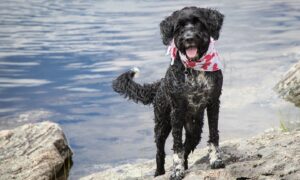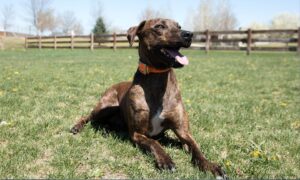Australian Cattle Dog
Updated December 15, 2025
Australian Cattle Dog
Updated December 15, 2025
Related to the wild dingo, Australian Cattle Dogs have a distinctly Down Under personality—they’re up for adventure in the outback (or just in your backyard) and they’ll never say no to a good brekky (or any other meal). This smart, loyal pup loves new escapades and will push you to see more of the world.
Adventurous, Intelligent, Loyal
35–50 pounds
17–20 inches
12–16 years
Blue, Blue Mottled, Blue Speckled, Red Speckled, Red Mottled
If you’ve seen the kids’ show “Bluey,” you know that Bluey is an Australian Cattle Dog, and so is her family. Also called Blue Heelers or Red Heelers, it’s no wonder these canines are so popular on TV, because they’re just as great in person: Playful with energy to spare, these pups need a pet parent who understands that life is more than just sitting in front of a screen.
This dog sees the world in technicolor and needs to be a part of it—not just watching. They’ll love weekends going on adventures with you, whether it’s camping, hiking, or anything else new and exciting.
If it’s a sporty activity that challenges their bright minds, Australian Cattle Dogs are here for it—and you’ll be super impressed by your dog’s athleticism and smarts. As Bluey and her sister Bingo would say, “Hooray!”
Australian Cattle Dog Characteristics
Australian Cattle Dog Appearance
Australian Cattle Dogs are born with a white coat and get their own bespoke looks—bluish-gray or red—as they grow up. Their pointy ears and angular faces are reminiscent of Australia’s wild dingo (they’re actually related!).

- Ears
Australian Cattle Dog ears are medium-sized and slightly pointed; they sit up straight when alert.
- Eyes
Their dark-brown eyes are thoughtful and intelligent.
- Nose
They typically have black noses.
- Coat Length
The Australian Cattle Dog typically has a double coat with a short, dense undercoat and a longer, rain-resistant outer coat.
- Coat Color
Australian Cattle Dog colors include blue, blue mottled, blue speckled, red mottled, and red-speckled. They also can have some tan around their face, neck, chest and hindquarters.
- Tail
The Australian Cattle Dog tail is set moderately low, and it has a slight curve when at rest.
Australian Cattle Dog Temperament
Australian Cattle Dogs are happiest when they’re busy. These pups need active pet parents who’ll go along on adventures. Being a homebody is not on this pup’s to-do list; they need activity and fun in the great big world.
These dogs have their own opinions and tend to be very independent-minded. Australian Cattle Dogs have their own ideas about things, but they’re affectionate and loyal and will eventually come around to your point of view. They’ll thank you by showing lots of affection at the end of the day—though they might appear slightly aloof to the average person. (It’s all an act; they’re really rather playful and charming.)
Note that Australian Cattle Dogs are also very smart, and giving them mental stimulation is just as important as physical exercise. These clever problem solvers are easily bored, so keep their brains buzzing with games and puzzle toys.
These pups can enjoy the company of kids and other dogs if they’re well-socialized. But, because of the Australian Cattle Dog’s strong herding instincts, they might not be a cat’s best friend.
How to Care for a Australian Cattle Dog
Daily exercise and training will take a lot more time than grooming (which is usually minimal), but these are all excellent opportunities to bond with your dog.
Grooming
Training
Diet
Exercise
Environment
Australian Cattle Dog Health
The average Australian Cattle Dog lifespan is 12–16 years. While they’re known for being one of the healthiest dogs around, there are a few health issues to be aware of.
- Deafness: Australian Cattle Dog puppies can be born deaf. There’s no treatment for inherited deafness, but most dogs acclimate well and lead a long, active life.
- Hip dysplasia: Hip dysplasia is when the hip and thigh bones don’t properly fit together. It’s an inherited condition that can be made worse if a pup is overweight and eventually leads to arthritis and pain. More severe cases may require surgery, but the condition is often treated with medications, joint supplements, and weight management.
- Progressive retinal atrophy (PRA): Australian Cattle Dogs are at higher risk for adult-onset PRA. PRA leads to blindness in dogs, and while there is no cure, pups who lose their eyesight tend to adapt well and can still live full, happy lives.
Australian Cattle Dog History
The origin of the Australian Cattle Dog began in the 19th century when the British brought a sheepdog to Australia. That dog, however, did not fare well on the rough Australian terrain (or in its sweltering heat), so they created a herding breed that would thrive Down Under.
The Australian Cattle Dog we know today is a cross between a dingo, a Collie, and a Dalmatian, according to the breed club. The breed first came to the U.S. in 1950, and they were recognized by the American Kennel Club in 1980.
Australian Cattle Dog puppies tend to cost between $600–$1,000. If you choose this route, pick a responsible breeder.
You can also adopt an Australian Cattle Dog, as there are many pups out there waiting for their forever families. Look for a local rescue like the American Cattle Dog Rescue Association, keep an eye out at your nearby animal shelter, or search Chewy’s database of adoptable dogs in your area to find your perfect pup.








